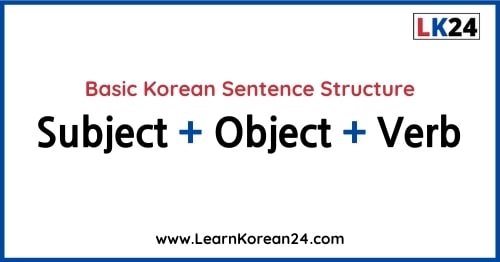How To Make Korean Sentences
In this lesson, you will learn the basic Korean sentence order, the basic structure of Korean sentences, and how to make Korean sentences.
Korean Sentence Structure

An important thing to remember about Korean sentence structure is that the verb comes at the end of a sentence. Korean sentences are made up of either a subject + verb or a subject + object + verb. Let’s look at some examples:
Subject+Verb
수민이 가요. [Su-min-e ga-yo] = Sumin Goes.
In this sentence, 수민 is the subject and 가요 is the verb.
Subject + Object + Verb
수민이 영화를 봐요. [Su-min-e yeong-hwa-reul bwa-yo] = Sumin watches movies.
In this sentence, 수민 is the subject, 영화 (movie) is the object, and 봐요 is the verb.
In Korean sentences, the order is subject object verb. So the sentence 수민이 영화를 봐요 literally says ‘Sumin movies watches.’ In English sentences, it is subject verb object (Sumin watches movies). If you have difficulty remembering the Korean sentence order, just remember that the verb always comes at the end of a sentence in Korean.
Korean Particles
Another important element in Korean sentences is the ‘Korean particle’. Korean particles are small words that are attached to another word which indicates the function or role of that word in the sentence. In the previous lesson on Korean particles, you learned the subject marking particle (이/가), the object marking particle (을/를) and the topic marking particle (은/는).
In the sentence 수민이 영화를 봐요 you can see that the subject (수민) is marked with the subject marking particle 이, and the object (영화) is marked with the object marking particle 를. There are many different particles in Korean and you will learn about these in future lessons.
Korean Verb Endings
Another important thing to know about Korean sentences is that you can easily change the tense, meaning, and politeness of a sentence by changing the ending that is attached to the verb.
Tense
You can change the tense of a Korean sentence by changing the verb ending. In the sentence 수민이 영화를 봐요, the basic verb is 보다. When conjugated in the present tense 보다 becomes 봐. By changing the ending attached to the verb, you can change the tense of the sentence. For example:
수민이 영화를 봐요 [Su-min-e yeong-hwa-reul bwa-yo] = Sumin watches a movie. (present tense)
수민이 영화를 봤어요 = [Su-min-e yeong-hwa-reul bwa-sseo-yo] Sumin watched a movie. (past tense)
수민이 영화를 볼 거예요 = [Su-min-e yeong-hwa-reul bol geo-ye-yo] Sumin will watch a movie. (future tense)
You will learn how to conjugate verbs into different tenses in future lessons. For now, just remember that you can change the tense of a sentence by changing the ending that is attached to the verb.
Politeness Level
In Korean sentences, you can also change the politeness of a sentence by changing the ending that is attached to the verb. In the sentence 수민이 영화를 봐요, you can see that 요 is attached to the end of the verb. This 요 makes the sentence polite. You can make the sentence without 요 (수민이 영화를 봐) but it is not polite. You can also replace this 요 with other endings to make your sentences sound more formal and respectful. Here are some examples:
수민이 영화를 봐. [Su-min-e yeong-hwa-reul bwa] = Sumin watches movies. (casual/impolite)
수민이 영화를 봐요. [Su-min-e yeong-hwa-reul bwa-yo] = Sumin watches movies. (polite)
수민이 영화를 봅니다. [Su-min-e yeong-hwa-reul bom-ni-da] = Sumin watches movies. (formal)
In future lessons, you will learn more about the different politeness levels and honorific endings and how to conjugate them with different verbs. For now, just remember that in Korean sentences you can change how polite/respectful a sentence is by changing the ending attached to the verb.
Other Verb Endings
There are many other verb endings in Korean which you can attach to a verb to change the meaning of the sentence. Again, these will be covered in more detail in future lessons, but here are some examples to explain what we mean:
영화를 봐요 [yeong-hwa-reul bwa-yo] = (I) watch a movie.
영화를 보고 싶어요 [yeong-hwa-reul bo-go sip-eo-yo] = (I) want to watch a movie.
영화를 보세요 [yeong-hwa-reul bo-se-yo] = Please watch a movie.
As you can see, by changing the ending attached to the verb 보다 you can change the meaning of the sentence.
Review
In this lesson, you learned that the basic order of Korean sentences is subject + verb or subject + object + verb. You also learned that Korean sentences often include ‘particles’ which can indicate the function or role a word plays in a sentence. And, you also learned that by adding different endings to the verb in a Korean sentence, you can change the tense, politeness, and meaning of the sentence.
Armed with this knowledge, as you learn more Korean vocabulary, Korean particles, and Korean verb endings, you’ll be able to make more and more complex sentences.
Review Quiz
Using the words below make the following sentences in Korean in the present tense with the polite ending 요. Then click on the + sign to check the answer. If you need to review how to conjugate the present tense, click here.
Subject
- 수민 (Sumin)
- 선우 (Seonu)
- 크리스 (Chris)
Object
- 피자 (pizza)
- 책 (book)
- 케이크 (cake)
Verb
- 먹다 (to eat)
- 좋아하다 (to like)
- 읽다 (to read)
STUDY ONLINE WITH KOREAN ARAH!
Ready to take your Korean to the next level?
Get One-on-One Korean lessons from a qualified and experienced Korean language tutor!

